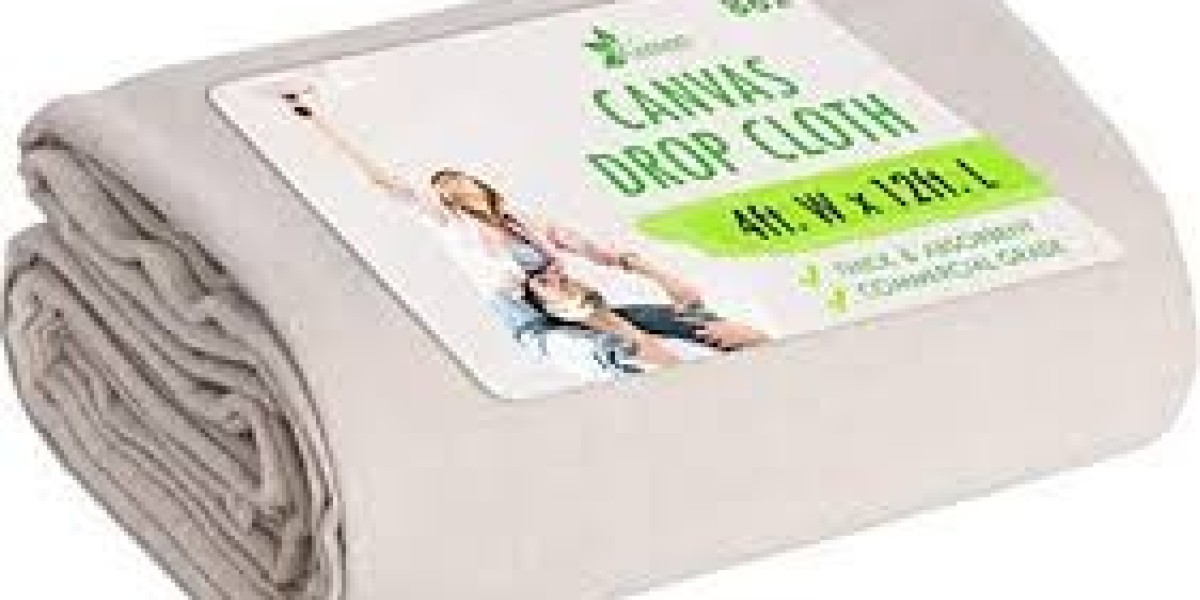When undertaking any painting project, protecting your floors, furniture, and other surfaces is essential. This is where paint drop cloths become invaluable. These protective coverings prevent paint splatters, spills, and dust from damaging your belongings or workspace. Choosing the right material for your paint drop cloths plays a significant role in how effective they are for your project. The most common materials are canvas, plastic, and paper, each with its unique advantages and disadvantages. Understanding these materials helps you select the best drop cloth for your specific painting needs.
Why Understanding the Different Materials Used in Paint Drop Cloths Is Crucial for Your Painting Project Success
Before purchasing paint drop cloths, it’s important to understand the differences between canvas, plastic, and paper materials. Each type offers distinct protection levels, durability, and ease of use.
Canvas Paint Drop Cloths: Made from woven cotton, canvas drop cloths are thick, durable, and reusable. They absorb paint rather than allowing it to pool, which minimizes slipping hazards. Canvas is ideal for indoor projects on hardwood floors, tiles, or carpet.
Plastic Paint Drop Cloths: Manufactured from polyethylene or similar materials, plastic drop cloths are lightweight, waterproof, and inexpensive. They are best for quick projects or outdoor use where water resistance is a must, but they can be slippery.
Paper Paint Drop Cloths: Usually composed of heavy kraft paper or rosin-coated paper, paper drop cloths are disposable and environmentally friendly. They are absorbent but less durable than canvas and plastic, making them suitable for small or one-time projects.
Knowing how each material functions can help you prevent costly accidents or damage during your painting.
How Canvas Paint Drop Cloths Provide Durable and Reusable Protection for Your Floors and Furniture
Canvas paint drop cloths are highly favored by professionals for their durability and reusability.
Thickness and Weight: Canvas is a heavy fabric that provides excellent coverage against paint splatters and dust.
Absorbency: Canvas absorbs paint spills instead of letting paint pool on the surface, reducing slip hazards.
Non-Slip Surface: The woven texture creates a rough surface that stays put on floors, preventing tripping or slipping.
Reusable Nature: Canvas drop cloths can be washed and reused multiple times, making them eco-friendly and cost-effective over time.
Suitability for Indoor Use: Ideal for hardwood, laminate, and carpeted floors, canvas drop cloths protect delicate surfaces from scratches and stains.
However, canvas cloths tend to be heavier and more expensive than plastic or paper, and they require cleaning after use.
Why Plastic Paint Drop Cloths Are a Lightweight and Waterproof Option for Quick and Outdoor Painting Jobs
Plastic paint drop cloths are popular due to their affordability and water resistance.
Waterproof Protection: Plastic materials create a barrier that prevents paint, water, and solvents from reaching the underlying surface.
Lightweight and Portable: Easy to carry and position, plastic drop cloths are perfect for quick cleanups and outdoor projects.
Cost-Effective: These are typically cheaper than canvas drop cloths, making them suitable for one-time or infrequent use.
Drawbacks Include Slipperiness and Tear Risk: Plastic drop cloths can be slick, increasing the risk of slips. They are also prone to ripping or puncturing under heavy use.
Ideal for Protecting Concrete, Decks, and Outdoor Furniture: Plastic drop cloths work well on rough surfaces or outdoors where water resistance and quick disposal are key.
For projects involving water-based paints or requiring moisture protection, plastic drop cloths serve as an effective choice.
How Paper Paint Drop Cloths Offer an Environmentally Friendly and Disposable Solution for Small Painting Projects
Paper paint drop cloths, including kraft paper and rosin paper, offer unique benefits for specific painting needs.
Eco-Friendly and Biodegradable: Made from natural fibers, paper drop cloths break down easily and are recyclable.
Easy Cleanup with Disposable Use: Since they are disposable, you can simply roll up and discard paper drop cloths after use.
Good Absorption of Paint: Paper absorbs paint spills, reducing dripping and mess during work.
Less Durable and More Prone to Tearing: Paper drop cloths are not suitable for heavy-duty or multiple uses and can tear if exposed to moisture.
Best for Small Indoor Jobs or Touch-Ups: Ideal for quick fixes or projects on smooth, less delicate surfaces where minimal protection is needed.
Paper drop cloths provide a convenient and environmentally responsible option when durability is less of a priority.
How Considering the Size and Thickness of Paint Drop Cloths Affects Their Performance and Coverage
Choosing the correct size and thickness of paint drop cloths is critical to protect your workspace adequately.
Proper Size Selection: Measure the area to be covered, ensuring the cloth is large enough to cover floors, furniture, or fixtures with some overlap.
Thickness Impact on Durability: Thicker cloths resist tears and punctures better, especially for canvas and plastic options.
Weight and Handling: Heavier drop cloths stay in place more effectively but may be harder to manage; lightweight cloths are easier to move but can shift during work.
Single Layer vs. Multi-Layer Options: Some plastic drop cloths feature reinforced layers for extra strength.
Assessing size and thickness ensures comprehensive coverage and fewer mishaps from exposed surfaces.
Why Evaluating the Intended Painting Environment Is Essential When Choosing Between Canvas, Plastic, and Paper Paint Drop Cloths
The environment in which you plan to use paint drop cloths influences your material choice.
Indoor vs. Outdoor Use: Canvas is excellent indoors on smooth floors, while plastic is better for outdoors or damp conditions.
Moisture and Weather Exposure: For wet or rainy conditions, waterproof plastic prevents moisture damage.
Surface Type: Delicate hardwood floors benefit from soft canvas, while concrete or rough surfaces can handle plastic or paper.
Duration of the Project: For long-term or frequent use, durable canvas or reinforced plastic drop cloths are more practical.
Understanding your environment allows you to select drop cloths that perform well and protect effectively.
How Budget Constraints and Frequency of Use Influence the Choice of Paint Drop Cloth Material
Your budget and how often you paint can guide the best drop cloth purchase.
One-Time or Occasional Use: Plastic or paper drop cloths offer affordable protection without a significant investment.
Frequent or Professional Use: Canvas drop cloths are more cost-effective long-term due to reusability.
Cost vs. Quality Trade-Off: Cheaper plastic cloths may save money upfront but can rip easily, leading to replacement costs.
Balancing Investment and Protection Needs: Weighing initial costs against durability helps avoid overspending or inadequate protection.
Budget planning ensures you invest appropriately in drop cloths tailored to your painting schedule.
How Special Features Like Reinforced Edges and Non-Slip Surfaces Improve the Usability of Paint Drop Cloths
Extra features can enhance safety and convenience when using paint drop cloths.
Reinforced Edges for Longevity: Prevents fraying and tearing, particularly important in canvas and plastic options.
Non-Slip Backings or Textured Surfaces: Reduce the risk of slips and movement on smooth floors.
Foldability and Compact Storage: Lightweight materials that fold easily simplify transportation and storage.
Waterproof Coatings: Useful for canvas drop cloths that are treated to repel water and paint.
Selecting cloths with these practical features can improve overall project safety and efficiency.
Why Proper Care and Maintenance Extend the Life and Effectiveness of Paint Drop Cloths
Maintaining your paint drop cloths prolongs their usability and protects your investment.
Cleaning After Use: Remove paint splatters or stains promptly from canvas cloths.
Drying and Storage: Ensure cloths are completely dry before folding and storing to prevent mildew.
Repairing Minor Damage: Patch small tears or holes to maintain protection.
Avoiding Harsh Chemicals: Use gentle cleaners to preserve material integrity.
Regular upkeep keeps paint drop cloths ready for multiple projects and reduces the need for frequent replacements.
How User Preferences and Project Requirements Guide the Choice Between Canvas, Plastic, and Paper Paint Drop Cloths
Personal preferences and project specifics play a major role in deciding the ideal paint drop cloth.
Preference for Eco-Friendly Materials: Paper and cotton canvas appeal to environmentally conscious users.
Need for Maximum Durability: Canvas drop cloths are preferred for heavy-duty, professional painting jobs.
Preference for Convenience and Quick Cleanup: Plastic and paper cloths offer fast, disposable solutions.
Project Size and Complexity: Larger, complex projects benefit from durable, reusable canvas cloths for extensive coverage.
Taking these factors into account helps users find drop cloths that align with their painting style and project demands.
Choosing the right paint drop cloths material depends on your painting project’s nature, environment, and budget. Canvas offers durability and reusability, plastic provides waterproof convenience, and paper delivers disposable eco-friendliness. Understanding these materials’ properties ensures you protect your surfaces effectively and complete your painting projects with minimal mess and maximum safety.








